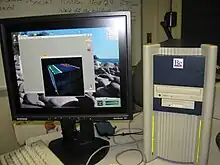BeBox
The BeBox is a dual CPU personal computer, briefly sold by Be Inc. to run the company's own operating system, BeOS. It has PowerPC CPUs, its I/O board has a custom "GeekPort", and the front bezel has "Blinkenlights".
 A BeBox, with aftermarket monitor | |
| Manufacturer | Be Inc. |
|---|---|
| Type | Workstation |
| Release date | BeBox Dual603-66: October 3, 1995[1] BeBox Dual603e-133: August 5, 1996[2] |
| Introductory price | BeBox Dual603-66 US$1,600 (equivalent to $3,070 in 2022) BeBox Dual603e-133 US$2,995 (equivalent to $5,590 in 2022) |
| Discontinued | January 1997 |
| Units sold | 1000 – BeBox Dual603-66 800 – BeBox Dual603e-133[3] |
| Operating system | BeOS |
| CPU | 2× PowerPC 603 @ 66 MHz, or 2× PowerPC 603e @ 133 MHz[4] |
| Memory | Up to 256 MB (Up to eight 72-pin SIMMs) |
| Power | 100–240 volt AC single-phase |
| Dimensions | 15.68 in × 8.28 in × 18.15 in 39.8 cm × 21.0 cm × 46.1 cm |
| Website | Historical: www.be.com[5] |
The BeBox made its debut in October 1995 in a dual PowerPC 603 at 66 MHz configuration.[6] The processors were upgraded to 133 MHz in August 1996 (BeBox Dual603e-133). Production was halted in January 1997,[7][8] following the port of BeOS to the Macintosh, in order for the company to concentrate on software. Be sold around 1000 66 MHz BeBoxes and 800 133 MHz BeBoxes.[3]
BeBox creator Jean-Louis Gassée did not see the BeBox as a general consumer device, warning that "Before we let you use the BeBox, we believe you must have some aptitude toward programming – the standard language is C++."[9]
CPU configuration
Initial prototypes are equipped with two AT&T Hobbit processors and three AT&T 9308S DSPs.[10]
Production models use two 66 MHz PowerPC 603 processors or two 133 MHz PowerPC 603e processors to power the BeBox. Prototypes having dual 200 MHz CPUs or four CPUs exist, but were never publicly available.[11]
Main board
The main board is in a standard AT format commonly found on PC. It used standard PC components to make it as inexpensive as possible.[12]
- Two PowerPC 603/66 MHz or 603e/133 MHz processors
- Eight 72-pin SIMM sockets
- 128 KB Flash ROM
- Three PCI slots
- Five ISA slots
- Internal SCSI connector
- Internal IDE connector
- Internal floppy connector
- External SCSI-2 connector
- Parallel port
- Keyboard port, AT-style
- Three GeekPort fuses
- I/O Board connector
- Front panel connector
- Power connector
I/O board
.jpg.webp)
The I/O board offers four serial ports (9-pin D-sub), a PS/2 mouse port, and two joystick ports (15-pin D-sub).
There are four DIN MIDI ports (two in, two out), two stereo pairs of RCA connectors audio line-level input and output, and a pair of 3.5 mm stereo phono jacks for microphone input and headphone output. There are also internal audio connectors: 5-pin strip for the audio CD line-level playback, and two 4-pin strips for microphone input and headphone output. The audio is produced with a 16-bit DAC stereo sound system capable of 48 kHz and 44.1 kHz.[12]
For the more unusual uses, there are three 4-pin mini-DIN infrared (IR) I/O ports.
GeekPort
An experimental-electronic-development oriented port, backed by three fuses on the mainboard, the 37-pin D-sub "GeekPort" provides digital and analog I/O and DC power[13] on the ISA bus:
- Two independent, bidirectional 8-bit ports
- Four A/D pins routing to a 12-bit A/D converter
- Four D/A pins connected to an independent 8-bit D/A converter
- Two signal ground reference pins
- Eleven power and ground pins: Two at +5 V, one at +12 V, one at -12 V, seven ground pins
"Blinkenlights"
Two yellow/green vertical LED arrays, dubbed the "blinkenlights", are built into the front bezel to illustrate the CPU load. The bottommost LED on the right side indicates hard disk activity.
See also
- Multi Emulator Super System (MESS) – able to emulate both BeBox 66 Archived 2015-06-21 at the Wayback Machine and 133 Archived 2015-06-21 at the Wayback Machine
References
- "Jean-Louis Gassée Unveils the BeBox" (Press release). October 3, 1995. Archived from the original on 2000-01-28. for the original BeBox Dual603-66.
- "Be Announces the BeBox Dual603-133" (Press release). August 5, 1996. Archived from the original on 2000-01-28.
- The BeBox, General, FAQ, How many BeBoxes were sold before they were discontinued? Be, Inc.
- Be Product Datasheet, The BeBox Dual603, BeBox Dual603-66, BeBox Dual603-133
- "Be, Inc". Archived from the original on 1996-10-20. Retrieved 2015-04-28.
{{cite web}}: CS1 maint: bot: original URL status unknown (link) - Picarille, Lisa (16 October 1995). "Video Be-in". Computerworld. Vol. 29, no. 42. p. 45.
- "BeBox History, 1997". The BeBox Zone. Archived from the original on 4 February 2012.
- "Briefly Noted". InfoWorld. Vol. 19, no. 5. 3 February 1997. p. 3.
- "New Amiga Prepares to Kill Mac/PC". Next Generation. No. 21. Imagine Media. September 1996. p. 21.
- "Introduction to the Be machine and the BeBus". Archived from the original (JPEG) on 21 February 2017.
- "Interview with Joseph Palmer". Be Informed, The BeBox Zone. 2 December 2005. Archived from the original on 24 February 2008.
- Mark, Dave (January 1997). "The Wizards of Be, Inc". MacTech. Vol. 13, no. 1. p. 52-56.
- "Pinout for the GeekPort connector". Retrieved 18 August 2021.
External links
- Mark, Dave (January 1997). "The Wizards of Be, Inc". MacTech. Vol. 13, no. 1. p. 52-56. – An interview with Be Inc. CEO Jean-Louis Gassée and VP of Engineering Erich Ringewald.
- Potrebic, Peter; Horowitz, Steve (January 1996). "Opening the BeBox". MacTech. Vol. 12, no. 1. p. 25-45.
- "The BeBox Zone". Archived from the original on 15 April 2013.
- BeBox Photo Gallery (Joseph Palmer: Be HW Engineer)
- U.S. Trademark 75,054,089 (BeBox)